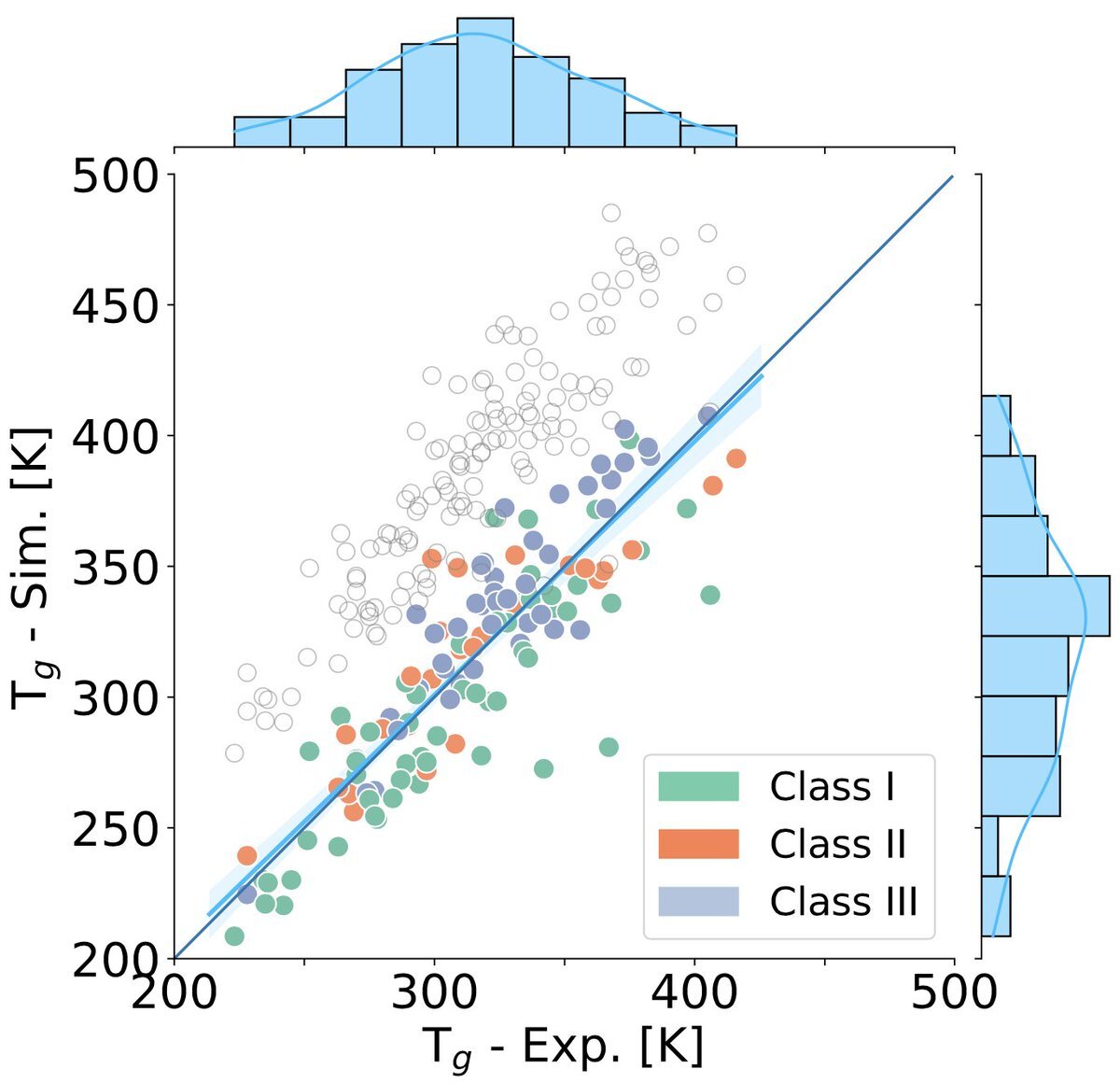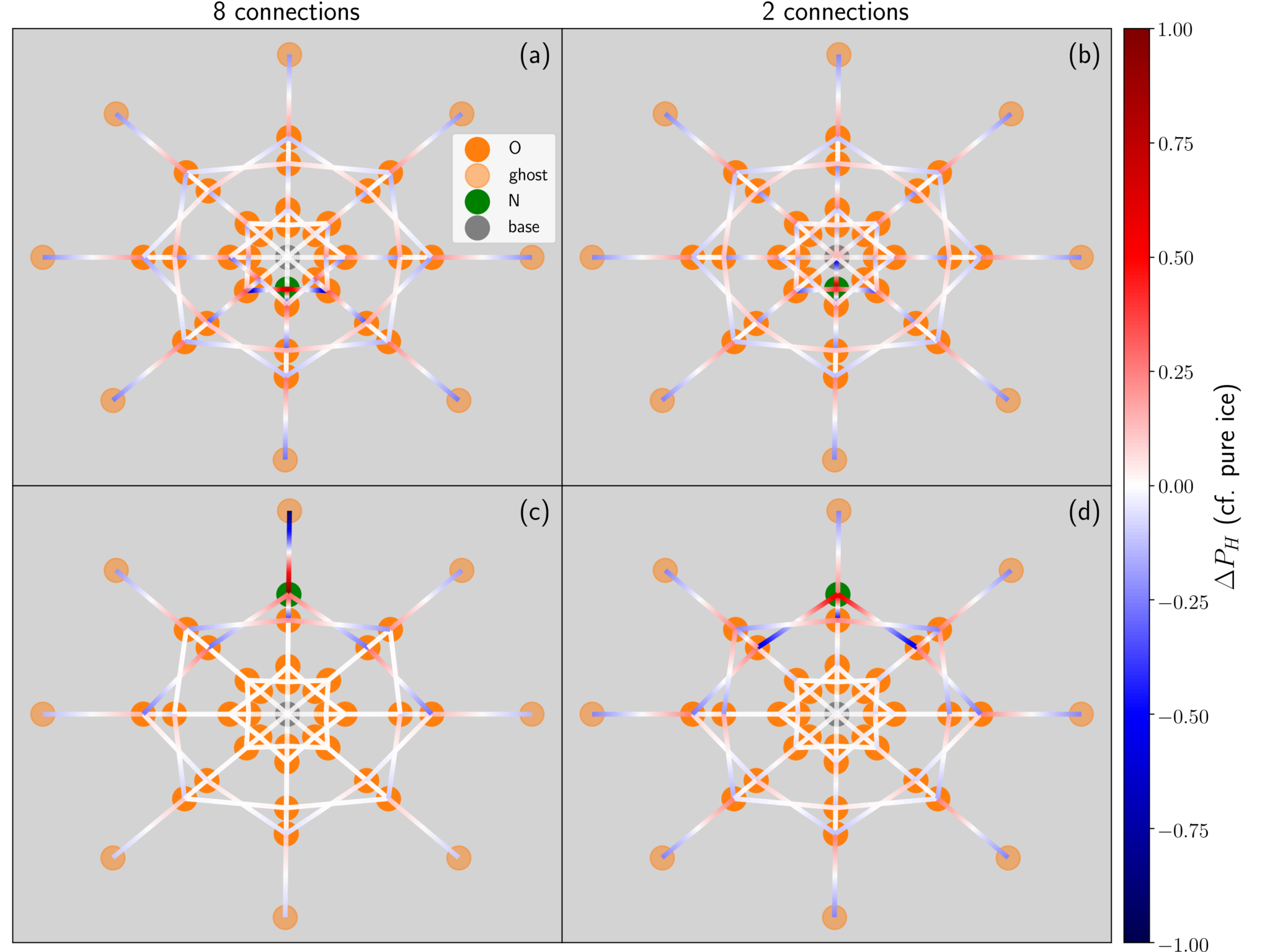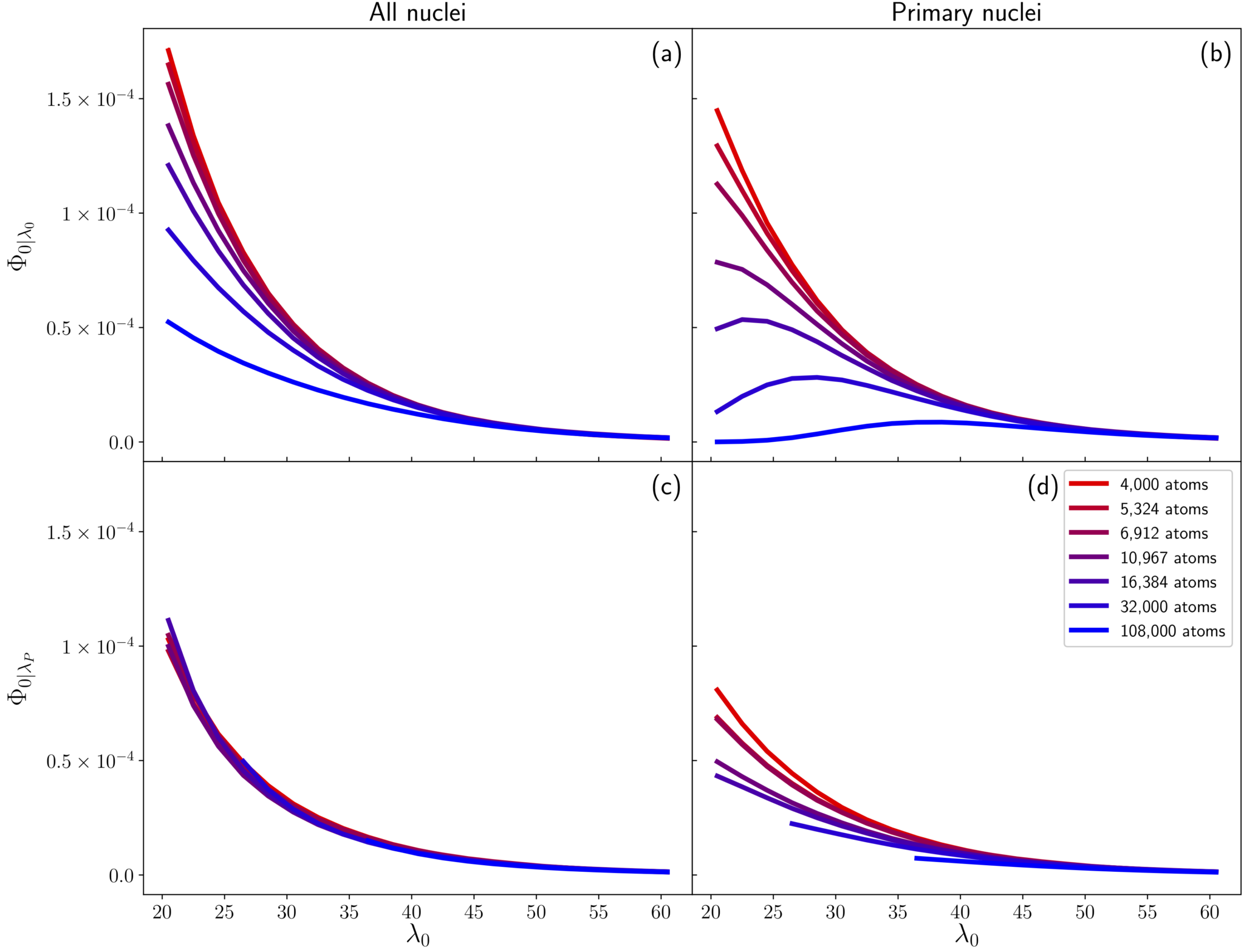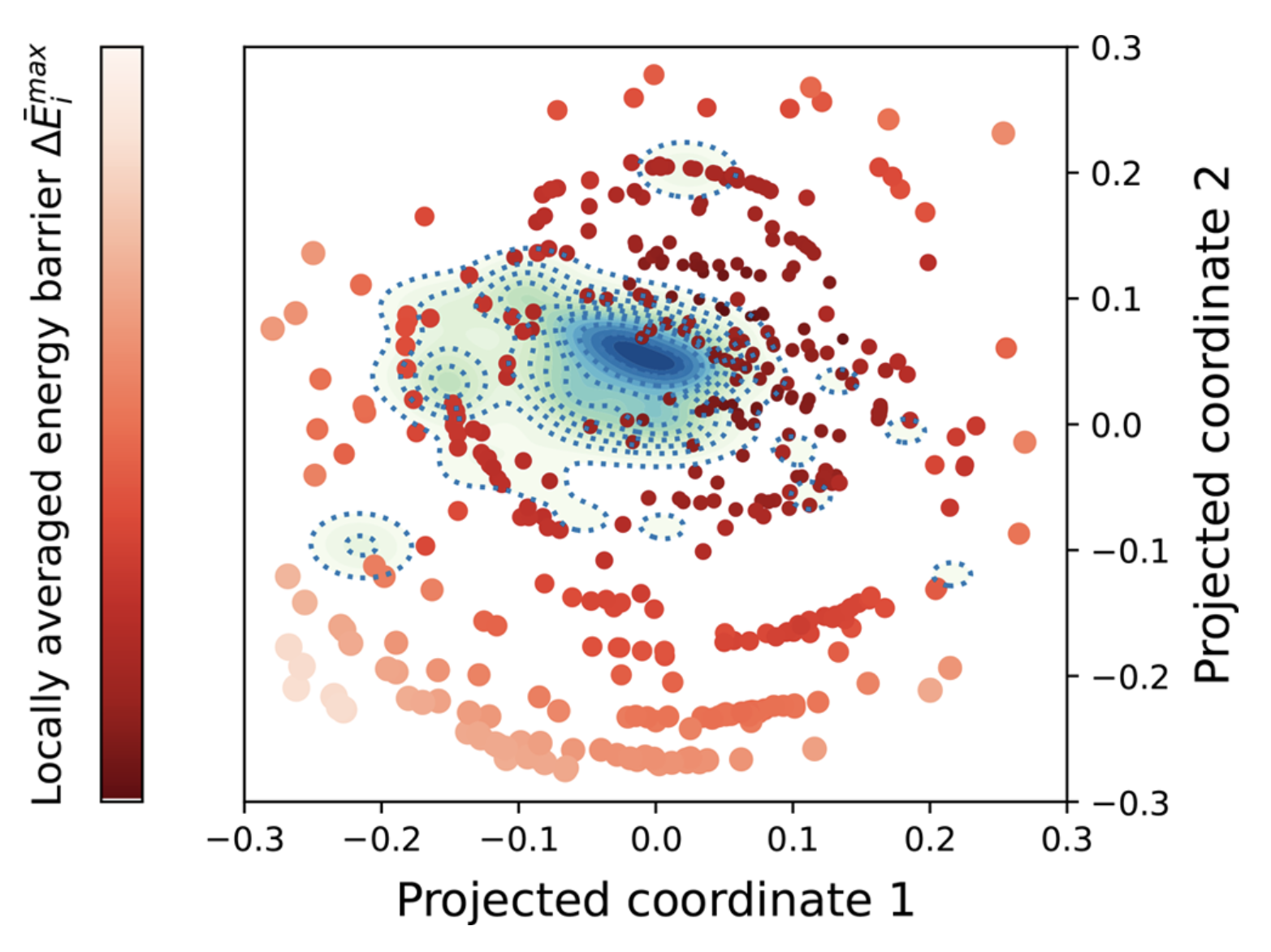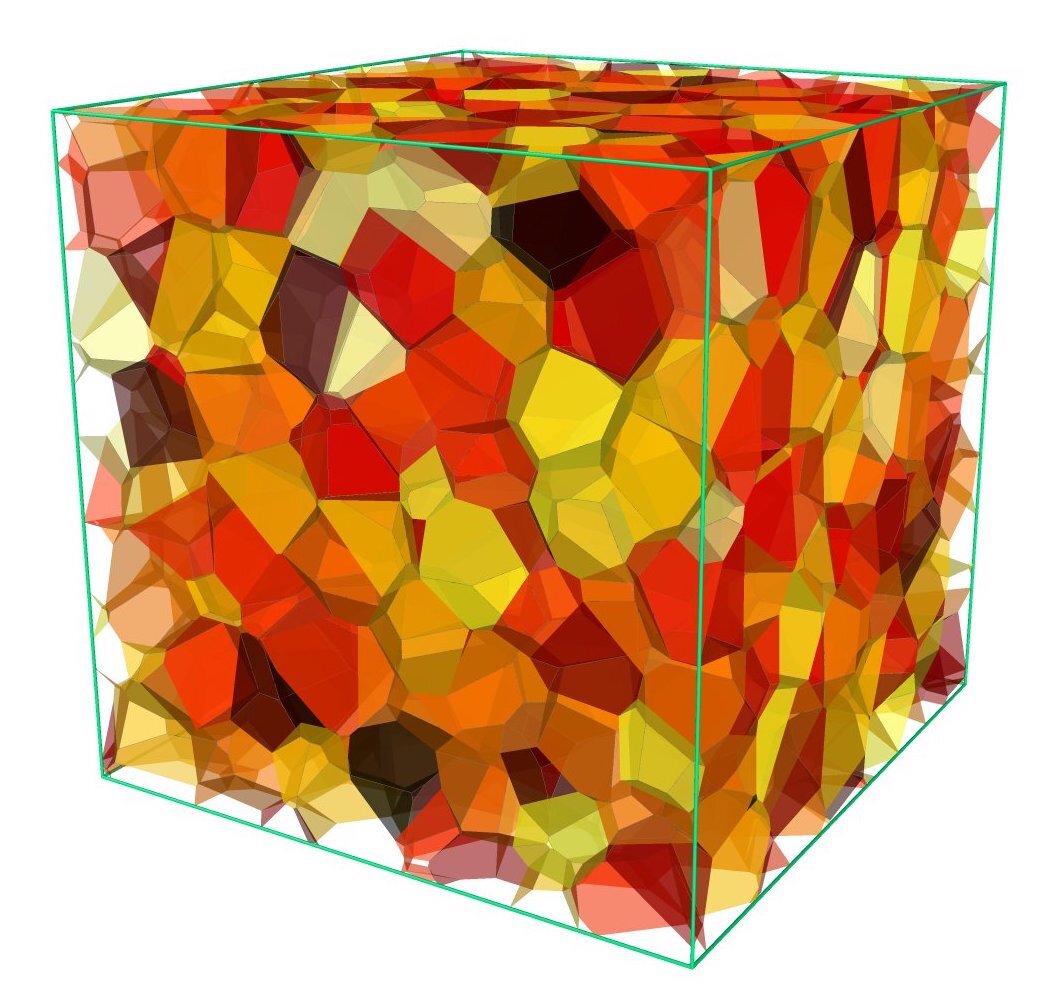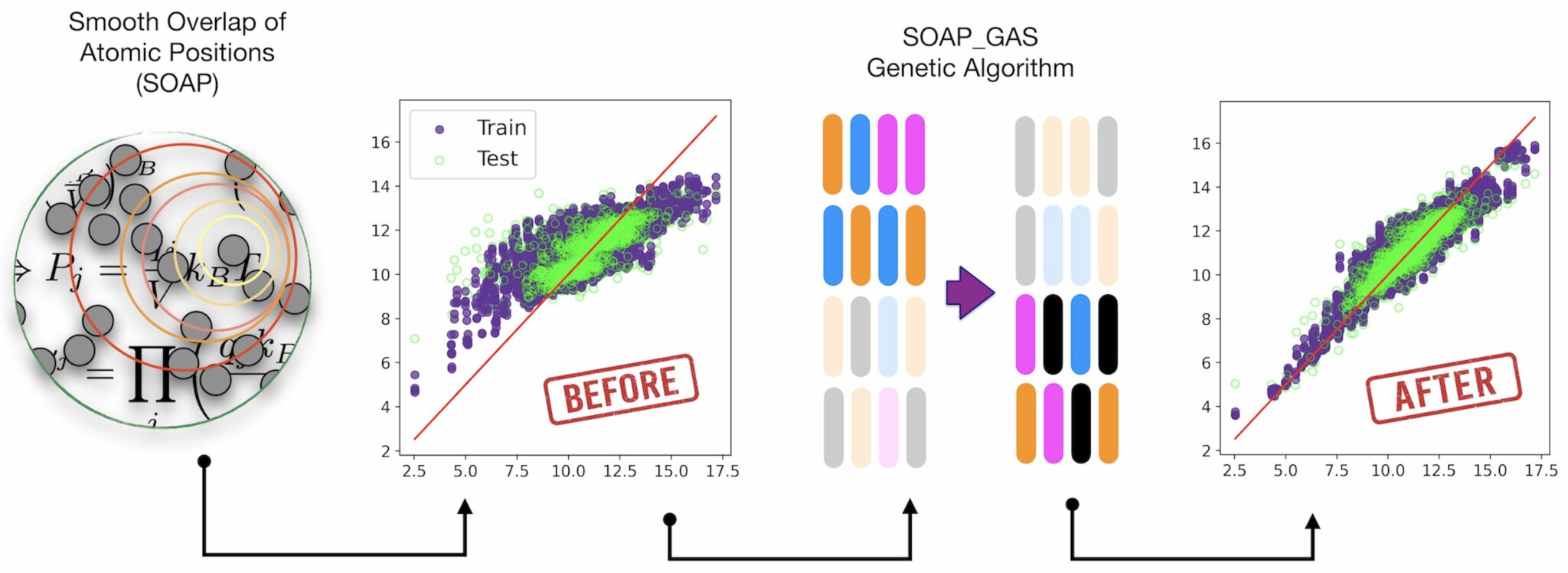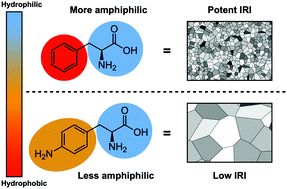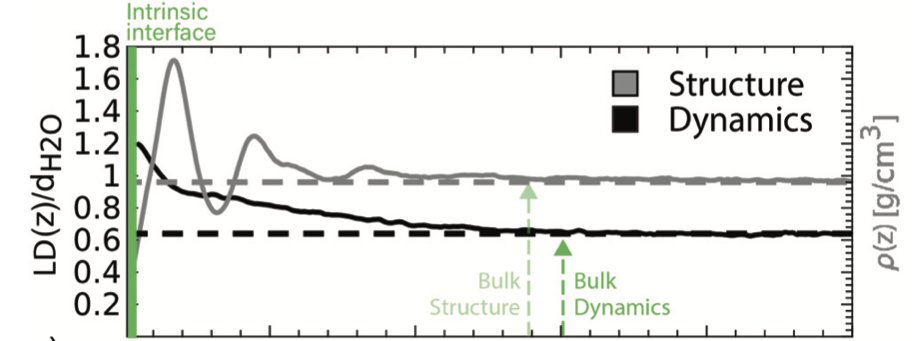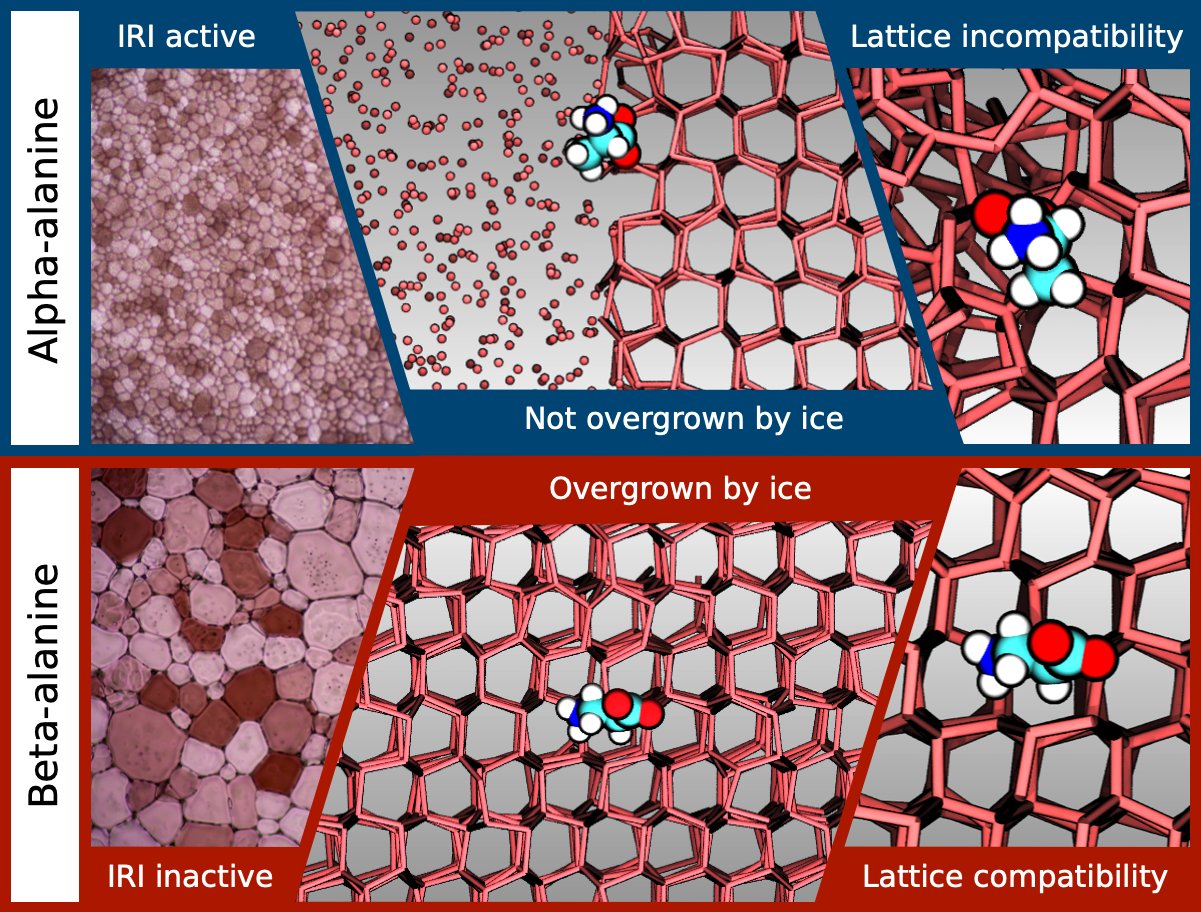Highlights
Full Publications List
2016
Sosso, Gabriele C; Tribello, Gareth A; Zen, Andrea; Pedevilla, Philipp; Michaelides, Angelos
Ice formation on kaolinite: Insights from molecular dynamics simulations Journal Article
In: The Journal of Chemical Physics, vol. 145, no. 21, pp. 211927, 2016.
@article{sosso2016ice,
title = {Ice formation on kaolinite: Insights from molecular dynamics simulations},
author = {Gabriele C Sosso and Gareth A Tribello and Andrea Zen and Philipp Pedevilla and Angelos Michaelides},
year = {2016},
date = {2016-01-01},
journal = {The Journal of Chemical Physics},
volume = {145},
number = {21},
pages = {211927},
publisher = {AIP Publishing},
keywords = {},
pubstate = {published},
tppubtype = {article}
}
Sosso, Gabriele Cesare; Caravati, Sebastiano; Rotskoff, Grant; Vaikuntanathan, Suriyanarayan; Hassanali, Ali
On the Role of Nonspherical Cavities in Short Length-Scale Density Fluctuations in Water Journal Article
In: The Journal of Physical Chemistry A, vol. 121, no. 1, pp. 370–380, 2016.
@article{sosso2016role,
title = {On the Role of Nonspherical Cavities in Short Length-Scale Density Fluctuations in Water},
author = {Gabriele Cesare Sosso and Sebastiano Caravati and Grant Rotskoff and Suriyanarayan Vaikuntanathan and Ali Hassanali},
year = {2016},
date = {2016-01-01},
journal = {The Journal of Physical Chemistry A},
volume = {121},
number = {1},
pages = {370--380},
publisher = {American Chemical Society},
keywords = {},
pubstate = {published},
tppubtype = {article}
}
2015
Fitzner, Martin; Sosso, Gabriele C; Cox, Stephen J; Michaelides, Angelos
The Many Faces of Heterogeneous Ice Nucleation: Interplay Between Surface Morphology and Hydrophobicity Journal Article
In: Journal of the American Chemical Society, vol. 137, no. 42, pp. 13658–13669, 2015, ISSN: 0002-7863, 1520-5126.
@article{fitzner_many_2015,
title = {The Many Faces of Heterogeneous Ice Nucleation: Interplay Between Surface Morphology and Hydrophobicity},
author = {Martin Fitzner and Gabriele C Sosso and Stephen J Cox and Angelos Michaelides},
url = {http://pubs.acs.org/doi/10.1021/jacs.5b08748},
doi = {10.1021/jacs.5b08748},
issn = {0002-7863, 1520-5126},
year = {2015},
date = {2015-10-01},
urldate = {2018-04-16},
journal = {Journal of the American Chemical Society},
volume = {137},
number = {42},
pages = {13658--13669},
keywords = {},
pubstate = {published},
tppubtype = {article}
}
Sosso, Gabriele C; Salvalaglio, Matteo; Behler, Jörg; Bernasconi, Marco; Parrinello, Michele
Heterogeneous Crystallization of the Phase Change Material GeTe via Atomistic Simulations Journal Article
In: The Journal of Physical Chemistry C, vol. 119, no. 11, pp. 6428–6434, 2015, ISSN: 1932-7447, 1932-7455.
@article{sosso_heterogeneous_2015,
title = {Heterogeneous Crystallization of the Phase Change Material GeTe via Atomistic Simulations},
author = {Gabriele C Sosso and Matteo Salvalaglio and Jörg Behler and Marco Bernasconi and Michele Parrinello},
url = {http://pubs.acs.org/doi/10.1021/acs.jpcc.5b00296},
doi = {10.1021/acs.jpcc.5b00296},
issn = {1932-7447, 1932-7455},
year = {2015},
date = {2015-03-01},
urldate = {2018-04-16},
journal = {The Journal of Physical Chemistry C},
volume = {119},
number = {11},
pages = {6428--6434},
keywords = {},
pubstate = {published},
tppubtype = {article}
}
Campi, D; Baldi, E; Graceffa, G; Sosso, G C; Bernasconi, M
Electron–phonon interaction and thermal boundary resistance at the interfaces of Ge2Sb2Te5 with metals and dielectrics Journal Article
In: Journal of Physics: Condensed Matter, vol. 27, no. 17, pp. 175009, 2015, ISSN: 0953-8984, 1361-648X.
@article{campi_electronphonon_2015,
title = {Electron–phonon interaction and thermal boundary resistance at the interfaces of Ge2Sb2Te5 with metals and dielectrics},
author = {D Campi and E Baldi and G Graceffa and G C Sosso and M Bernasconi},
url = {http://stacks.iop.org/0953-8984/27/i=17/a=175009?key=crossref.4d7b664bea22f99f7f0ff0ceb7d10aa7},
doi = {10.1088/0953-8984/27/17/175009},
issn = {0953-8984, 1361-648X},
year = {2015},
date = {2015-01-01},
urldate = {2018-04-16},
journal = {Journal of Physics: Condensed Matter},
volume = {27},
number = {17},
pages = {175009},
keywords = {},
pubstate = {published},
tppubtype = {article}
}
Campi, Davide; Donadio, Davide; Sosso, Gabriele C; Behler, Jörg; Bernasconi, Marco
Electron-phonon interaction and thermal boundary resistance at the crystal-amorphous interface of the phase change compound GeTe Journal Article
In: Journal of Applied Physics, vol. 117, no. 1, pp. 015304, 2015, ISSN: 0021-8979, 1089-7550.
@article{campi_electron-phonon_2015,
title = {Electron-phonon interaction and thermal boundary resistance at the crystal-amorphous interface of the phase change compound GeTe},
author = {Davide Campi and Davide Donadio and Gabriele C Sosso and Jörg Behler and Marco Bernasconi},
url = {http://aip.scitation.org/doi/10.1063/1.4904910},
doi = {10.1063/1.4904910},
issn = {0021-8979, 1089-7550},
year = {2015},
date = {2015-01-01},
urldate = {2018-04-16},
journal = {Journal of Applied Physics},
volume = {117},
number = {1},
pages = {015304},
keywords = {},
pubstate = {published},
tppubtype = {article}
}
Caravati, Sebastiano; Sosso, Gabriele C; Bernasconi, Marco
Functional Properties of Phase Change Materials from Atomistic Simulations Book Section
In: Massobrio, Carlo; Du, Jincheng; Bernasconi, Marco; Salmon, Philip S (Ed.): Molecular Dynamics Simulations of Disordered Materials, vol. 215, pp. 415–440, Springer International Publishing, Cham, 2015, ISBN: 978-3-319-15674-3 978-3-319-15675-0.
@incollection{massobrio_functional_2015,
title = {Functional Properties of Phase Change Materials from Atomistic Simulations},
author = {Sebastiano Caravati and Gabriele C Sosso and Marco Bernasconi},
editor = {Carlo Massobrio and Jincheng Du and Marco Bernasconi and Philip S Salmon},
url = {http://link.springer.com/10.1007/978-3-319-15675-0_15},
doi = {10.1007/978-3-319-15675-0_15},
isbn = {978-3-319-15674-3 978-3-319-15675-0},
year = {2015},
date = {2015-01-01},
urldate = {2018-04-16},
booktitle = {Molecular Dynamics Simulations of Disordered Materials},
volume = {215},
pages = {415--440},
publisher = {Springer International Publishing},
address = {Cham},
keywords = {},
pubstate = {published},
tppubtype = {incollection}
}
Gabardi, S; Caravati, S; Sosso, G C; Behler, J; Bernasconi, M
Microscopic origin of resistance drift in the amorphous state of the phase-change compound GeTe Journal Article
In: Physical Review B, vol. 92, no. 5, 2015, ISSN: 1098-0121, 1550-235X.
@article{gabardi_microscopic_2015,
title = {Microscopic origin of resistance drift in the amorphous state of the phase-change compound GeTe},
author = {S Gabardi and S Caravati and G C Sosso and J Behler and M Bernasconi},
url = {https://link.aps.org/doi/10.1103/PhysRevB.92.054201},
doi = {10.1103/PhysRevB.92.054201},
issn = {1098-0121, 1550-235X},
year = {2015},
date = {2015-01-01},
urldate = {2018-04-16},
journal = {Physical Review B},
volume = {92},
number = {5},
keywords = {},
pubstate = {published},
tppubtype = {article}
}
Campi, Davide; Donadio, Davide; Sosso, Gabriele C; Behler, Jörg; Bernasconi, Marco
Electron-phonon interaction and thermal boundary resistance at the crystal-amorphous interface of the phase change compound GeTe Journal Article
In: Journal of Applied Physics, vol. 117, no. 1, pp. 015304, 2015.
@article{campi2015electron,
title = {Electron-phonon interaction and thermal boundary resistance at the crystal-amorphous interface of the phase change compound GeTe},
author = {Davide Campi and Davide Donadio and Gabriele C Sosso and Jörg Behler and Marco Bernasconi},
year = {2015},
date = {2015-01-01},
journal = {Journal of Applied Physics},
volume = {117},
number = {1},
pages = {015304},
publisher = {AIP Publishing},
keywords = {},
pubstate = {published},
tppubtype = {article}
}
Sosso, Gabriele C; Salvalaglio, Matteo; Behler, Jörg; Bernasconi, Marco; Parrinello, Michele
Heterogeneous crystallization of the phase change material GeTe via atomistic simulations Journal Article
In: The Journal of Physical Chemistry C, vol. 119, no. 11, pp. 6428–6434, 2015.
@article{sosso2015heterogeneous,
title = {Heterogeneous crystallization of the phase change material GeTe via atomistic simulations},
author = {Gabriele C Sosso and Matteo Salvalaglio and Jörg Behler and Marco Bernasconi and Michele Parrinello},
year = {2015},
date = {2015-01-01},
journal = {The Journal of Physical Chemistry C},
volume = {119},
number = {11},
pages = {6428--6434},
publisher = {American Chemical Society},
keywords = {},
pubstate = {published},
tppubtype = {article}
}
Caravati, Sebastiano; Sosso, Gabriele C; Bernasconi, Marco
Functional Properties of Phase Change Materials from Atomistic Simulations Book Section
In: Molecular Dynamics Simulations of Disordered Materials, pp. 415–440, Springer, 2015.
@incollection{caravati2015functional,
title = {Functional Properties of Phase Change Materials from Atomistic Simulations},
author = {Sebastiano Caravati and Gabriele C Sosso and Marco Bernasconi},
year = {2015},
date = {2015-01-01},
booktitle = {Molecular Dynamics Simulations of Disordered Materials},
pages = {415--440},
publisher = {Springer},
keywords = {},
pubstate = {published},
tppubtype = {incollection}
}
Campi, D; Baldi, E; Graceffa, G; Sosso, GC; Bernasconi, M
Electron--phonon interaction and thermal boundary resistance at the interfaces of Ge2Sb2Te5 with metals and dielectrics Journal Article
In: Journal of Physics: Condensed Matter, vol. 27, no. 17, pp. 175009, 2015.
@article{campi2015electronb,
title = {Electron--phonon interaction and thermal boundary resistance at the interfaces of Ge2Sb2Te5 with metals and dielectrics},
author = {D Campi and E Baldi and G Graceffa and GC Sosso and M Bernasconi},
year = {2015},
date = {2015-01-01},
journal = {Journal of Physics: Condensed Matter},
volume = {27},
number = {17},
pages = {175009},
publisher = {IOP Publishing},
keywords = {},
pubstate = {published},
tppubtype = {article}
}
Gabardi, S; Caravati, S; Sosso, GC; Behler, J; Bernasconi, M
Microscopic origin of resistance drift in the amorphous state of the phase-change compound GeTe Journal Article
In: Physical Review B, vol. 92, no. 5, pp. 054201, 2015.
@article{gabardi2015microscopic,
title = {Microscopic origin of resistance drift in the amorphous state of the phase-change compound GeTe},
author = {S Gabardi and S Caravati and GC Sosso and J Behler and M Bernasconi},
year = {2015},
date = {2015-01-01},
journal = {Physical Review B},
volume = {92},
number = {5},
pages = {054201},
publisher = {American Physical Society},
keywords = {},
pubstate = {published},
tppubtype = {article}
}
Fitzner, Martin; Sosso, Gabriele C; Cox, Stephen J; Michaelides, Angelos
The many faces of heterogeneous ice nucleation: Interplay between surface morphology and hydrophobicity Journal Article
In: Journal of the American Chemical Society, vol. 137, no. 42, pp. 13658–13669, 2015.
@article{fitzner2015many,
title = {The many faces of heterogeneous ice nucleation: Interplay between surface morphology and hydrophobicity},
author = {Martin Fitzner and Gabriele C Sosso and Stephen J Cox and Angelos Michaelides},
year = {2015},
date = {2015-01-01},
journal = {Journal of the American Chemical Society},
volume = {137},
number = {42},
pages = {13658--13669},
publisher = {American Chemical Society},
keywords = {},
pubstate = {published},
tppubtype = {article}
}
2014
Hassanali, Ali A; Giberti, Federico; Sosso, Gabriele C; Parrinello, Michele
The role of the umbrella inversion mode in proton diffusion Journal Article
In: Chemical Physics Letters, vol. 599, pp. 133–138, 2014, ISSN: 00092614.
@article{hassanali_role_2014,
title = {The role of the umbrella inversion mode in proton diffusion},
author = {Ali A Hassanali and Federico Giberti and Gabriele C Sosso and Michele Parrinello},
url = {http://linkinghub.elsevier.com/retrieve/pii/S0009261414001857},
doi = {10.1016/j.cplett.2014.03.034},
issn = {00092614},
year = {2014},
date = {2014-04-01},
urldate = {2018-04-16},
journal = {Chemical Physics Letters},
volume = {599},
pages = {133--138},
keywords = {},
pubstate = {published},
tppubtype = {article}
}
Sosso, Gabriele C; Colombo, Jader; Behler, Jörg; Gado, Emanuela Del; Bernasconi, Marco
Dynamical Heterogeneity in the Supercooled Liquid State of the Phase Change Material GeTe Journal Article
In: The Journal of Physical Chemistry B, vol. 118, no. 47, pp. 13621–13628, 2014, ISSN: 1520-6106, 1520-5207.
@article{sosso_dynamical_2014,
title = {Dynamical Heterogeneity in the Supercooled Liquid State of the Phase Change Material GeTe},
author = {Gabriele C Sosso and Jader Colombo and Jörg Behler and Emanuela Del Gado and Marco Bernasconi},
url = {http://pubs.acs.org/doi/10.1021/jp507361f},
doi = {10.1021/jp507361f},
issn = {1520-6106, 1520-5207},
year = {2014},
date = {2014-01-01},
urldate = {2018-04-16},
journal = {The Journal of Physical Chemistry B},
volume = {118},
number = {47},
pages = {13621--13628},
keywords = {},
pubstate = {published},
tppubtype = {article}
}
Hassanali, Ali A; Giberti, Federico; Sosso, Gabriele C; Parrinello, Michele
The role of the umbrella inversion mode in proton diffusion Journal Article
In: Chemical Physics Letters, vol. 599, pp. 133–138, 2014.
@article{hassanali2014role,
title = {The role of the umbrella inversion mode in proton diffusion},
author = {Ali A Hassanali and Federico Giberti and Gabriele C Sosso and Michele Parrinello},
year = {2014},
date = {2014-01-01},
journal = {Chemical Physics Letters},
volume = {599},
pages = {133--138},
publisher = {North-Holland},
keywords = {},
pubstate = {published},
tppubtype = {article}
}
Sosso, Gabriele C; Colombo, Jader; Behler, Jörg; Gado, Emanuela Del; Bernasconi, Marco
Dynamical heterogeneity in the supercooled liquid state of the phase change material gete Journal Article
In: The Journal of Physical Chemistry B, vol. 118, no. 47, pp. 13621–13628, 2014.
@article{sosso2014dynamical,
title = {Dynamical heterogeneity in the supercooled liquid state of the phase change material gete},
author = {Gabriele C Sosso and Jader Colombo and Jörg Behler and Emanuela Del Gado and Marco Bernasconi},
year = {2014},
date = {2014-01-01},
journal = {The Journal of Physical Chemistry B},
volume = {118},
number = {47},
pages = {13621--13628},
publisher = {American Chemical Society},
keywords = {},
pubstate = {published},
tppubtype = {article}
}
2013
Mazzarello, Riccardo; Sosso, Gabriele Cesare; Miceli, Giacomo; Caravati, Sebastiano; Donadio, Davide; Behler, Jörg; Bernasconi, Marco
Nanosession: Phase Change Materials Book Section
In: Frontiers in Electronic Materials, pp. 155–162, Wiley-VCH Verlag GmbH & Co. KGaA, Weinheim, Germany, 2013, ISBN: 978-3-527-66770-3 978-3-527-41191-7.
@incollection{mazzarello_nanosession:_2013,
title = {Nanosession: Phase Change Materials},
author = {Riccardo Mazzarello and Gabriele Cesare Sosso and Giacomo Miceli and Sebastiano Caravati and Davide Donadio and Jörg Behler and Marco Bernasconi},
url = {http://doi.wiley.com/10.1002/9783527667703.ch37},
doi = {10.1002/9783527667703.ch37},
isbn = {978-3-527-66770-3 978-3-527-41191-7},
year = {2013},
date = {2013-04-01},
urldate = {2018-04-16},
booktitle = {Frontiers in Electronic Materials},
pages = {155--162},
publisher = {Wiley-VCH Verlag GmbH & Co. KGaA},
address = {Weinheim, Germany},
keywords = {},
pubstate = {published},
tppubtype = {incollection}
}
Caravati, Sebastiano; Sosso, Gabriele C; Bernasconi, Marco; Parrinello, Michele
Density functional simulations of hexagonal Ge2Sb2Te5 at high pressure Journal Article
In: Physical Review B, vol. 87, no. 9, 2013, ISSN: 1098-0121, 1550-235X.
@article{caravati_density_2013,
title = {Density functional simulations of hexagonal Ge2Sb2Te5 at high pressure},
author = {Sebastiano Caravati and Gabriele C Sosso and Marco Bernasconi and Michele Parrinello},
url = {https://link.aps.org/doi/10.1103/PhysRevB.87.094117},
doi = {10.1103/PhysRevB.87.094117},
issn = {1098-0121, 1550-235X},
year = {2013},
date = {2013-03-01},
urldate = {2018-04-16},
journal = {Physical Review B},
volume = {87},
number = {9},
keywords = {},
pubstate = {published},
tppubtype = {article}
}
Sosso, Gabriele C; Miceli, Giacomo; Caravati, Sebastiano; Giberti, Federico; Behler, Jörg; Bernasconi, Marco
Fast Crystallization of the Phase Change Compound GeTe by Large-Scale Molecular Dynamics Simulations Journal Article
In: The Journal of Physical Chemistry Letters, vol. 4, no. 24, pp. 4241–4246, 2013, ISSN: 1948-7185.
@article{sosso_fast_2013,
title = {Fast Crystallization of the Phase Change Compound GeTe by Large-Scale Molecular Dynamics Simulations},
author = {Gabriele C Sosso and Giacomo Miceli and Sebastiano Caravati and Federico Giberti and Jörg Behler and Marco Bernasconi},
url = {http://pubs.acs.org/doi/10.1021/jz402268v},
doi = {10.1021/jz402268v},
issn = {1948-7185},
year = {2013},
date = {2013-01-01},
urldate = {2018-04-16},
journal = {The Journal of Physical Chemistry Letters},
volume = {4},
number = {24},
pages = {4241--4246},
keywords = {},
pubstate = {published},
tppubtype = {article}
}
Caravati, Sebastiano; Sosso, Gabriele C; Bernasconi, Marco; Parrinello, Michele
Density functional simulations of hexagonal Ge 2 Sb 2 Te 5 at high pressure Journal Article
In: Physical Review B, vol. 87, no. 9, pp. 094117, 2013.
@article{caravati2013density,
title = {Density functional simulations of hexagonal Ge 2 Sb 2 Te 5 at high pressure},
author = {Sebastiano Caravati and Gabriele C Sosso and Marco Bernasconi and Michele Parrinello},
year = {2013},
date = {2013-01-01},
journal = {Physical Review B},
volume = {87},
number = {9},
pages = {094117},
publisher = {American Physical Society},
keywords = {},
pubstate = {published},
tppubtype = {article}
}
Sosso, Gabriele C; Miceli, Giacomo; Caravati, Sebastiano; Giberti, Federico; Behler, Jörg; Bernasconi, Marco
Fast crystallization of the phase change compound GeTe by large-scale molecular dynamics simulations Journal Article
In: The journal of physical chemistry letters, vol. 4, no. 24, pp. 4241–4246, 2013.
@article{sosso2013fast,
title = {Fast crystallization of the phase change compound GeTe by large-scale molecular dynamics simulations},
author = {Gabriele C Sosso and Giacomo Miceli and Sebastiano Caravati and Federico Giberti and Jörg Behler and Marco Bernasconi},
year = {2013},
date = {2013-01-01},
journal = {The journal of physical chemistry letters},
volume = {4},
number = {24},
pages = {4241--4246},
publisher = {American Chemical Society},
keywords = {},
pubstate = {published},
tppubtype = {article}
}
Sosso, Gabriele C; Miceli, G; Caravati, Sebastiano; Donadio, Davide; Behler, Jörg; Bernasconi, Marco
Nanosession: Phase Change Materials Book Section
In: Frontiers in Electronic Materials, pp. 157, Wiley-VCH Verlag GmbH & Co. KGaA, 2013.
@incollection{sosso2013nanosession,
title = {Nanosession: Phase Change Materials},
author = {Gabriele C Sosso and G Miceli and Sebastiano Caravati and Davide Donadio and Jörg Behler and Marco Bernasconi},
year = {2013},
date = {2013-01-01},
booktitle = {Frontiers in Electronic Materials},
pages = {157},
publisher = {Wiley-VCH Verlag GmbH & Co. KGaA},
keywords = {},
pubstate = {published},
tppubtype = {incollection}
}
2012
Sosso, G C; Behler, J; Bernasconi, M
Breakdown of Stokes-Einstein relation in the supercooled liquid state of phase change materials Journal Article
In: physica status solidi (b), vol. 249, no. 10, pp. 1880–1885, 2012, ISSN: 03701972.
@article{sosso_breakdown_2012b,
title = {Breakdown of Stokes-Einstein relation in the supercooled liquid state of phase change materials},
author = {G C Sosso and J Behler and M Bernasconi},
url = {http://doi.wiley.com/10.1002/pssb.201200355},
doi = {10.1002/pssb.201200355},
issn = {03701972},
year = {2012},
date = {2012-10-01},
urldate = {2018-04-16},
journal = {physica status solidi (b)},
volume = {249},
number = {10},
pages = {1880--1885},
keywords = {},
pubstate = {published},
tppubtype = {article}
}
Sosso, G C; Behler, J; Bernasconi, M
Breakdown of Stokes-Einstein relation in the supercooled liquid state of phase change materials Journal Article
In: Physica Status Solidi (b), vol. 249, no. 10, pp. 1880–1885, 2012, ISSN: 03701972.
@article{sosso_breakdown_2012b,
title = {Breakdown of Stokes-Einstein relation in the supercooled liquid state of phase change materials},
author = {G C Sosso and J Behler and M Bernasconi},
url = {http://doi.wiley.com/10.1002/pssb.201200355},
doi = {10.1002/pssb.201200355},
issn = {03701972},
year = {2012},
date = {2012-10-01},
urldate = {2018-04-16},
journal = {Physica Status Solidi (b)},
volume = {249},
number = {10},
pages = {1880--1885},
keywords = {},
pubstate = {published},
tppubtype = {article}
}
Sosso, Gabriele C; Donadio, Davide; Caravati, Sebastiano; Behler, Jörg; Bernasconi, Marco
Thermal transport in phase-change materials from atomistic simulations Journal Article
In: Physical Review B, vol. 86, no. 10, 2012, ISSN: 1098-0121, 1550-235X.
@article{sosso_thermal_2012,
title = {Thermal transport in phase-change materials from atomistic simulations},
author = {Gabriele C Sosso and Davide Donadio and Sebastiano Caravati and Jörg Behler and Marco Bernasconi},
url = {https://link.aps.org/doi/10.1103/PhysRevB.86.104301},
doi = {10.1103/PhysRevB.86.104301},
issn = {1098-0121, 1550-235X},
year = {2012},
date = {2012-09-01},
urldate = {2018-04-16},
journal = {Physical Review B},
volume = {86},
number = {10},
keywords = {},
pubstate = {published},
tppubtype = {article}
}
Sosso, Gabriele C; Donadio, Davide; Caravati, Sebastiano; Behler, Jörg; Bernasconi, Marco
Thermal transport in phase-change materials from atomistic simulations Journal Article
In: Physical Review B, vol. 86, no. 10, 2012, ISSN: 1098-0121, 1550-235X.
@article{sosso_thermal_2012b,
title = {Thermal transport in phase-change materials from atomistic simulations},
author = {Gabriele C Sosso and Davide Donadio and Sebastiano Caravati and Jörg Behler and Marco Bernasconi},
url = {https://link.aps.org/doi/10.1103/PhysRevB.86.104301},
doi = {10.1103/PhysRevB.86.104301},
issn = {1098-0121, 1550-235X},
year = {2012},
date = {2012-09-01},
urldate = {2018-04-16},
journal = {Physical Review B},
volume = {86},
number = {10},
keywords = {},
pubstate = {published},
tppubtype = {article}
}
Sosso, Gabriele C; Donadio, Davide; Caravati, Sebastiano; Behler, Jörg; Bernasconi, Marco
Thermal transport in phase-change materials from atomistic simulations Journal Article
In: Physical Review B, vol. 86, no. 10, 2012, ISSN: 1098-0121, 1550-235X.
@article{sosso_thermal_2012c,
title = {Thermal transport in phase-change materials from atomistic simulations},
author = {Gabriele C Sosso and Davide Donadio and Sebastiano Caravati and Jörg Behler and Marco Bernasconi},
url = {https://link.aps.org/doi/10.1103/PhysRevB.86.104301},
doi = {10.1103/PhysRevB.86.104301},
issn = {1098-0121, 1550-235X},
year = {2012},
date = {2012-09-01},
urldate = {2018-04-16},
journal = {Physical Review B},
volume = {86},
number = {10},
keywords = {},
pubstate = {published},
tppubtype = {article}
}
Sosso, Gabriele C; Miceli, Giacomo; Caravati, Sebastiano; Behler, Jörg; Bernasconi, Marco
Neural network interatomic potential for the phase change material GeTe Journal Article
In: Physical Review B, vol. 85, no. 17, 2012, ISSN: 1098-0121, 1550-235X.
@article{sosso_neural_2012,
title = {Neural network interatomic potential for the phase change material GeTe},
author = {Gabriele C Sosso and Giacomo Miceli and Sebastiano Caravati and Jörg Behler and Marco Bernasconi},
url = {https://link.aps.org/doi/10.1103/PhysRevB.85.174103},
doi = {10.1103/PhysRevB.85.174103},
issn = {1098-0121, 1550-235X},
year = {2012},
date = {2012-05-01},
urldate = {2018-04-16},
journal = {Physical Review B},
volume = {85},
number = {17},
keywords = {},
pubstate = {published},
tppubtype = {article}
}
Sosso, Gabriele C; Miceli, Giacomo; Caravati, Sebastiano; Behler, Jörg; Bernasconi, Marco
Neural network interatomic potential for the phase change material GeTe Journal Article
In: Physical Review B, vol. 85, no. 17, 2012, ISSN: 1098-0121, 1550-235X.
@article{sosso_neural_2012b,
title = {Neural network interatomic potential for the phase change material GeTe},
author = {Gabriele C Sosso and Giacomo Miceli and Sebastiano Caravati and Jörg Behler and Marco Bernasconi},
url = {https://link.aps.org/doi/10.1103/PhysRevB.85.174103},
doi = {10.1103/PhysRevB.85.174103},
issn = {1098-0121, 1550-235X},
year = {2012},
date = {2012-05-01},
urldate = {2018-04-16},
journal = {Physical Review B},
volume = {85},
number = {17},
keywords = {},
pubstate = {published},
tppubtype = {article}
}
Sosso, Gabriele C; Miceli, Giacomo; Caravati, Sebastiano; Behler, Jörg; Bernasconi, Marco
Neural network interatomic potential for the phase change material GeTe Journal Article
In: Physical Review B, vol. 85, no. 17, 2012, ISSN: 1098-0121, 1550-235X.
@article{sosso_neural_2012c,
title = {Neural network interatomic potential for the phase change material GeTe},
author = {Gabriele C Sosso and Giacomo Miceli and Sebastiano Caravati and Jörg Behler and Marco Bernasconi},
url = {https://link.aps.org/doi/10.1103/PhysRevB.85.174103},
doi = {10.1103/PhysRevB.85.174103},
issn = {1098-0121, 1550-235X},
year = {2012},
date = {2012-05-01},
urldate = {2018-04-16},
journal = {Physical Review B},
volume = {85},
number = {17},
keywords = {},
pubstate = {published},
tppubtype = {article}
}
Sosso, Gabriele C; Miceli, Giacomo; Caravati, Sebastiano; Behler, Jörg; Bernasconi, Marco
Neural network interatomic potential for the phase change material GeTe Journal Article
In: Physical Review B, vol. 85, no. 17, pp. 174103, 2012.
@article{sosso2012neural,
title = {Neural network interatomic potential for the phase change material GeTe},
author = {Gabriele C Sosso and Giacomo Miceli and Sebastiano Caravati and Jörg Behler and Marco Bernasconi},
year = {2012},
date = {2012-01-01},
journal = {Physical Review B},
volume = {85},
number = {17},
pages = {174103},
publisher = {APS},
keywords = {},
pubstate = {published},
tppubtype = {article}
}
Sosso, Gabriele C; Behler, Joerg; Bernasconi, Marco
Breakdown of Stokes--Einstein relation in the supercooled liquid state of phase change materials Journal Article
In: physica status solidi (b), vol. 249, no. 10, pp. 1880–1885, 2012.
@article{sosso2012breakdown,
title = {Breakdown of Stokes--Einstein relation in the supercooled liquid state of phase change materials},
author = {Gabriele C Sosso and Joerg Behler and Marco Bernasconi},
year = {2012},
date = {2012-01-01},
journal = {physica status solidi (b)},
volume = {249},
number = {10},
pages = {1880--1885},
publisher = {WILEY-VCH Verlag},
keywords = {},
pubstate = {published},
tppubtype = {article}
}
Sosso, Gabriele C; Donadio, Davide; Caravati, Sebastiano; Behler, Jörg; Bernasconi, Marco
Thermal transport in phase-change materials from atomistic simulations Journal Article
In: Physical Review B, vol. 86, no. 10, pp. 104301, 2012.
@article{sosso2012thermal,
title = {Thermal transport in phase-change materials from atomistic simulations},
author = {Gabriele C Sosso and Davide Donadio and Sebastiano Caravati and Jörg Behler and Marco Bernasconi},
year = {2012},
date = {2012-01-01},
journal = {Physical Review B},
volume = {86},
number = {10},
pages = {104301},
publisher = {APS},
keywords = {},
pubstate = {published},
tppubtype = {article}
}
2011
Sosso, Gabriele C; Caravati, Sebastiano; Mazzarello, Riccardo; Bernasconi, Marco
Raman spectra of cubic and amorphous Ge2Sb2Te5 from first principles Journal Article
In: Physical Review B, vol. 83, no. 13, 2011, ISSN: 1098-0121, 1550-235X.
@article{sosso_raman_2011,
title = {Raman spectra of cubic and amorphous Ge2Sb2Te5 from first principles},
author = {Gabriele C Sosso and Sebastiano Caravati and Riccardo Mazzarello and Marco Bernasconi},
url = {https://link.aps.org/doi/10.1103/PhysRevB.83.134201},
doi = {10.1103/PhysRevB.83.134201},
issn = {1098-0121, 1550-235X},
year = {2011},
date = {2011-04-01},
urldate = {2018-04-16},
journal = {Physical Review B},
volume = {83},
number = {13},
keywords = {},
pubstate = {published},
tppubtype = {article}
}
Sosso, Gabriele C; Caravati, Sebastiano; Mazzarello, Riccardo; Bernasconi, Marco
Raman spectra of cubic and amorphous Ge2Sb2Te5 from first principles Journal Article
In: Physical Review B, vol. 83, no. 13, 2011, ISSN: 1098-0121, 1550-235X.
@article{sosso_raman_2011b,
title = {Raman spectra of cubic and amorphous Ge2Sb2Te5 from first principles},
author = {Gabriele C Sosso and Sebastiano Caravati and Riccardo Mazzarello and Marco Bernasconi},
url = {https://link.aps.org/doi/10.1103/PhysRevB.83.134201},
doi = {10.1103/PhysRevB.83.134201},
issn = {1098-0121, 1550-235X},
year = {2011},
date = {2011-04-01},
urldate = {2018-04-16},
journal = {Physical Review B},
volume = {83},
number = {13},
keywords = {},
pubstate = {published},
tppubtype = {article}
}
Sosso, Gabriele C; Caravati, Sebastiano; Mazzarello, Riccardo; Bernasconi, Marco
Raman spectra of cubic and amorphous Ge2Sb2Te5 from first principles Journal Article
In: Physical Review B, vol. 83, no. 13, 2011, ISSN: 1098-0121, 1550-235X.
@article{sosso_raman_2011c,
title = {Raman spectra of cubic and amorphous Ge2Sb2Te5 from first principles},
author = {Gabriele C Sosso and Sebastiano Caravati and Riccardo Mazzarello and Marco Bernasconi},
url = {https://link.aps.org/doi/10.1103/PhysRevB.83.134201},
doi = {10.1103/PhysRevB.83.134201},
issn = {1098-0121, 1550-235X},
year = {2011},
date = {2011-04-01},
urldate = {2018-04-16},
journal = {Physical Review B},
volume = {83},
number = {13},
keywords = {},
pubstate = {published},
tppubtype = {article}
}
Sosso, Gabriele C; Caravati, Sebastiano; Mazzarello, Riccardo; Bernasconi, Marco
Raman spectra of cubic and amorphous Ge 2 Sb 2 Te 5 from first principles Journal Article
In: Physical Review B, vol. 83, no. 13, pp. 134201, 2011.
@article{sosso2011raman,
title = {Raman spectra of cubic and amorphous Ge 2 Sb 2 Te 5 from first principles},
author = {Gabriele C Sosso and Sebastiano Caravati and Riccardo Mazzarello and Marco Bernasconi},
year = {2011},
date = {2011-01-01},
journal = {Physical Review B},
volume = {83},
number = {13},
pages = {134201},
publisher = {American Physical Society},
keywords = {},
pubstate = {published},
tppubtype = {article}
}
2009
Sosso, G C; Caravati, S; Gatti, C; Assoni, S; Bernasconi, M
Vibrational properties of hexagonal Ge2Sb2Te5 from first principles Journal Article
In: Journal of Physics: Condensed Matter, vol. 21, no. 24, pp. 245401, 2009, ISSN: 0953-8984, 1361-648X.
@article{sosso_vibrational_2009,
title = {Vibrational properties of hexagonal Ge2Sb2Te5 from first principles},
author = {G C Sosso and S Caravati and C Gatti and S Assoni and M Bernasconi},
url = {http://stacks.iop.org/0953-8984/21/i=24/a=245401?key=crossref.6ee540f3ac1995e3461defc33aa16c09},
doi = {10.1088/0953-8984/21/24/245401},
issn = {0953-8984, 1361-648X},
year = {2009},
date = {2009-06-01},
urldate = {2018-04-16},
journal = {Journal of Physics: Condensed Matter},
volume = {21},
number = {24},
pages = {245401},
keywords = {},
pubstate = {published},
tppubtype = {article}
}
Sosso, G C; Caravati, S; Gatti, C; Assoni, S; Bernasconi, M
Vibrational properties of hexagonal Ge2Sb2Te5 from first principles Journal Article
In: Journal of Physics: Condensed Matter, vol. 21, no. 24, pp. 245401, 2009, ISSN: 0953-8984, 1361-648X.
@article{sosso_vibrational_2009c,
title = {Vibrational properties of hexagonal Ge2Sb2Te5 from first principles},
author = {G C Sosso and S Caravati and C Gatti and S Assoni and M Bernasconi},
url = {http://stacks.iop.org/0953-8984/21/i=24/a=245401?key=crossref.6ee540f3ac1995e3461defc33aa16c09},
doi = {10.1088/0953-8984/21/24/245401},
issn = {0953-8984, 1361-648X},
year = {2009},
date = {2009-06-01},
urldate = {2018-04-16},
journal = {Journal of Physics: Condensed Matter},
volume = {21},
number = {24},
pages = {245401},
keywords = {},
pubstate = {published},
tppubtype = {article}
}
Sosso, G C; Caravati, S; Gatti, C; Assoni, S; Bernasconi, M
Vibrational properties of hexagonal Ge2Sb2Te5 from first principles Journal Article
In: Journal of Physics: Condensed Matter, vol. 21, no. 24, pp. 245401, 2009, ISSN: 0953-8984, 1361-648X.
@article{sosso_vibrational_2009e,
title = {Vibrational properties of hexagonal Ge2Sb2Te5 from first principles},
author = {G C Sosso and S Caravati and C Gatti and S Assoni and M Bernasconi},
url = {http://stacks.iop.org/0953-8984/21/i=24/a=245401?key=crossref.6ee540f3ac1995e3461defc33aa16c09},
doi = {10.1088/0953-8984/21/24/245401},
issn = {0953-8984, 1361-648X},
year = {2009},
date = {2009-06-01},
urldate = {2018-04-16},
journal = {Journal of Physics: Condensed Matter},
volume = {21},
number = {24},
pages = {245401},
keywords = {},
pubstate = {published},
tppubtype = {article}
}
Sosso, G C; Caravati, S; Bernasconi, M
Vibrational properties of crystalline Sb2Te3 from first principles Journal Article
In: Journal of Physics: Condensed Matter, vol. 21, no. 9, pp. 095410, 2009, ISSN: 0953-8984, 1361-648X.
@article{sosso_vibrational_2009-1,
title = {Vibrational properties of crystalline Sb2Te3 from first principles},
author = {G C Sosso and S Caravati and M Bernasconi},
url = {http://stacks.iop.org/0953-8984/21/i=9/a=095410?key=crossref.d25774715f64060387b5157f7385914c},
doi = {10.1088/0953-8984/21/9/095410},
issn = {0953-8984, 1361-648X},
year = {2009},
date = {2009-03-01},
urldate = {2018-04-16},
journal = {Journal of Physics: Condensed Matter},
volume = {21},
number = {9},
pages = {095410},
keywords = {},
pubstate = {published},
tppubtype = {article}
}
Sosso, G C; Caravati, S; Bernasconi, M
Vibrational properties of crystalline Sb2Te3 from first principles Journal Article
In: Journal of Physics: Condensed Matter, vol. 21, no. 9, pp. 095410, 2009, ISSN: 0953-8984, 1361-648X.
@article{sosso_vibrational_2009-1b,
title = {Vibrational properties of crystalline Sb2Te3 from first principles},
author = {G C Sosso and S Caravati and M Bernasconi},
url = {http://stacks.iop.org/0953-8984/21/i=9/a=095410?key=crossref.d25774715f64060387b5157f7385914c},
doi = {10.1088/0953-8984/21/9/095410},
issn = {0953-8984, 1361-648X},
year = {2009},
date = {2009-03-01},
urldate = {2018-04-16},
journal = {Journal of Physics: Condensed Matter},
volume = {21},
number = {9},
pages = {095410},
keywords = {},
pubstate = {published},
tppubtype = {article}
}
Sosso, G C; Caravati, S; Bernasconi, M
Vibrational properties of crystalline Sb2Te3 from first principles Journal Article
In: Journal of Physics: Condensed Matter, vol. 21, no. 9, pp. 095410, 2009, ISSN: 0953-8984, 1361-648X.
@article{sosso_vibrational_2009-1c,
title = {Vibrational properties of crystalline Sb2Te3 from first principles},
author = {G C Sosso and S Caravati and M Bernasconi},
url = {http://stacks.iop.org/0953-8984/21/i=9/a=095410?key=crossref.d25774715f64060387b5157f7385914c},
doi = {10.1088/0953-8984/21/9/095410},
issn = {0953-8984, 1361-648X},
year = {2009},
date = {2009-03-01},
urldate = {2018-04-16},
journal = {Journal of Physics: Condensed Matter},
volume = {21},
number = {9},
pages = {095410},
keywords = {},
pubstate = {published},
tppubtype = {article}
}
Sosso, GC; Caravati, S; Bernasconi, M
Vibrational properties of crystalline Sb2Te3 from first principles Journal Article
In: Journal of Physics: Condensed Matter, vol. 21, no. 9, pp. 095410, 2009.
@article{sosso2009vibrational,
title = {Vibrational properties of crystalline Sb2Te3 from first principles},
author = {GC Sosso and S Caravati and M Bernasconi},
year = {2009},
date = {2009-01-01},
journal = {Journal of Physics: Condensed Matter},
volume = {21},
number = {9},
pages = {095410},
publisher = {IOP Publishing},
keywords = {},
pubstate = {published},
tppubtype = {article}
}
Sosso, GC; Caravati, S; Gatti, C; Assoni, S; Bernasconi, M
Vibrational properties of hexagonal Ge2Sb2Te5 from first principles Journal Article
In: Journal of Physics: Condensed Matter, vol. 21, no. 24, pp. 245401, 2009.
@article{sosso2009vibrationalb,
title = {Vibrational properties of hexagonal Ge2Sb2Te5 from first principles},
author = {GC Sosso and S Caravati and C Gatti and S Assoni and M Bernasconi},
year = {2009},
date = {2009-01-01},
journal = {Journal of Physics: Condensed Matter},
volume = {21},
number = {24},
pages = {245401},
publisher = {IOP Publishing},
keywords = {},
pubstate = {published},
tppubtype = {article}
}
0000
Sosso, GC; Sudera, P; Backes, AT; Whale, TF; Fröhlich-Nowoisky, J; Bonn, M; Michaelides, A; Backus, EHG
The role of structural order in heterogeneous ice nucleation Journal Article Forthcoming
In: Chemical Science, Forthcoming.
@article{Sosso2022Structural,
title = {The role of structural order in heterogeneous ice nucleation},
author = {GC Sosso and P Sudera and AT Backes and TF Whale and J Fröhlich-Nowoisky and M Bonn and A Michaelides and EHG Backus},
url = {https://sossogroup.uk/wp-content/uploads/2022/04/StructuralOrderIceNucleation.pdf},
doi = { 10.1039/d1sc06338c},
journal = {Chemical Science},
keywords = {},
pubstate = {forthcoming},
tppubtype = {article}
}
Warren, MT; Galpin, I; Hasan, M; Hindmarsh, SA; Padrnos, JD; Edwards-Gayle, C; Mathers, RT; Adams, DJ; Sosso, GC; Gibson, MI
Minimalistic ice recrystallisation inhibitors based on phenylalanine Journal Article Forthcoming
In: Chemical Communications, Forthcoming.
@article{Warren2022Minimalistic,
title = {Minimalistic ice recrystallisation inhibitors based on phenylalanine},
author = {MT Warren and I Galpin and M Hasan and SA Hindmarsh and JD Padrnos and C Edwards-Gayle and RT Mathers and DJ Adams and GC Sosso and MI Gibson },
url = {https://sossogroup.uk/wp-content/uploads/2022/06/Warren2022Minimalistic.pdf},
doi = {10.1039/D2CC02531K},
journal = {Chemical Communications},
keywords = {},
pubstate = {forthcoming},
tppubtype = {article}
}


